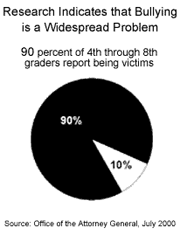
 ALL STUDENTS HAVE A RIGHT to learn in a safe, supportive school environment that is free of violence, as well as the bullying, intimidation and harassment that can lead to outbreaks of violence.
ALL STUDENTS HAVE A RIGHT to learn in a safe, supportive school environment that is free of violence, as well as the bullying, intimidation and harassment that can lead to outbreaks of violence.
Research has begun to draw a firm connection between acts of bullying and high-profile acts of violence, such as the 1999 shootings in Littleton, Colorado. Perpetrators of violent crimes at schools have indicated they were motivated by revenge against those who had bullied and tormented them for years.
The pervasiveness and impacts of bullying have been underestimated. To shed more light on the problem, and provide solutions, Governor Gary Locke, Attorney General Christine Gregoire and State Superintendent of Public Instruction Terry Bergeson have joined forces to protect our children's safety and ensure that schools are places of learning, free from the threat of violence. 
A Serious Problem
Traditionally, "bullying" has not been taken seriously. Too often, acts of bullying have been ignored with comments like "boys will be boys," or that kids picking on each other is "just part of growing up." Research shows, however, that bullying is widespread and that there can be serious consequences when children are bullied because of their appearance, race, ethnic background, disabilities or sexual orientation. It also shows that intervention can be effective. For example:
- 80 percent of adolescents report being bullied during their school years.
- Bullies identified by age eight are six times more likely to be convicted of a crime by age 24 and five times more likely to end up with serious criminal records by age 30.
- 71 percent of students report that teachers or other adults in the classroom ignored bullying incidents.
- Bullying begins in elementary school, peaks in middle school and diminishes but does not disappear in high school.
- Most bullying is verbal.
- Effective programs to prevent bullying can actually reduce the level of violence in a school.
School Safety Starts Here
| "Bullying is a range of behaviors, both verbal and physical, that intimidate others and often lead to antisocial and unlawful acts. Bullying should neither be thought of as a 'kids will be kids' occurrence nor accepted as a way of life." International Association of Chiefs of Police, Guide for Preventing and Responding to School Violence |
There is no single answer to this problem. Legislation alone will not stop every bully from physically or verbally tormenting a peer. However, this common-sense legislation is an important first-step toward bringing bullying out of the shadows of school hallways and playgrounds and establishing its prominence as a threat to the safety of our children.
Common Sense Solutions
The anti-bullying bill supported by the Governor, Attorney General and Superintendent of Public Instruction proposes to:
- Require that school districts ban bullying, harassment and intimidation. Schools would be required to notify students of the policy. Further, the bill would require districts to incorporate information about the anti-bullying policy into their existing faculty training programs.
- Require school districts to discuss the policy with students and train all school employees and volunteers who have significant contact with students.
- Encourage schools and school districts to form bullying prevention task forces, programs, and other initiatives that involve school staff, students, administrators, volunteers, parents, law enforcement and community members.
- Reinforce that students and school staff have a right to report harassment without fear of retaliation.
- Encourage employees who witness bullying to report it to the proper authorities, and grant them civil immunity from damages if they make such reports promptly.
STAFF CONTACT:
Dick Van Wagenen, Office of the Governor
Phone: (360) 902-0651
Fax: (360) 586-8380
Email: [email protected]
Home
Governor Locke
- About the Governor
- Cabinet
- Senior Staff
- Executive Orders
- Proclamations
- Boards and Commissions
- Contact the Governor
The First Lady
News Room
About Washington
- Washington State Facts
- Photo Gallery
- The 50 State QuartersTM Program
- State Legislature
- Washington Courts
- US Census 2000
- Register to Vote